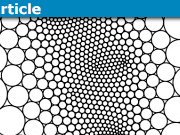Spectral Standard Model and String Compactifications
Show Complete Series
Part 1: It Was 20 Years Ago Today — the M-theory Conjecture
Part 2: Homotopy Lie-n Algebras in Supergravity
Part 3: Emergence from the Superpoint
Part 4: Why supersymmetry? Because of Deligne’s theorem
Part 5: 11d Gravity from just the Torsion Constraint
Part 6: Spectral Standard Model and String Compactifications
Part 7: Super p-Brane Theory emerging from Super Homotopy Theory
The Connes-Lott-Chamseddine-Barrett model is the observation that the standard model of particle physics — as a classical action functional, but including its coupling to gravity and subsuming a fair bit of fine detail — may succinctly be encoded in terms of operator algebraic data called a “spectral triple”. This involves some non-commutative algebra, and as such is often referred to as the “noncommutative standard model“. The key point however is the “spectral” aspect: in this model, all spacetime geometry and particle content are encoded in the spectrum of a Dirac-like operator, hence in terms of what a spinning quantum particle sees that propagates through such a background.
Sometimes this perspective is perceived as, and sometimes it is also presented as, being drastically different from traditional perspectives in high energy particle physics. But this is not the case. Apart from some difference in terminology, the encoding of particle physics models in spectral triples is just the point-particle analog of the encoding of perturbative string theory backgrounds in 2-dimensional super-conformal field theories (2d SCFTs). Hence 2d SCFTs are really “2-dimensional spectral triples” (i.e. stringy spectral triples). Of course, the concept of encoding spacetime geometry by 2d SCFTs precedes the concept of spectral triples, but in the theory of spectral triples, it is made more systematic.
This relation has long been understood, conceptually, by some, and has meanwhile also partly been turned into theorems by others. But by and large, the relation is underappreciated. Here I will informally explain the conceptual relationship and provide pointers (at the end) to references that provide technical details. There does remain much room to explore this relationship in more depth.
Table of Contents
Effective spacetime geometry is seen by a quantum particle
The term “spectral triple” sounds technical, but the idea is really simple: it just means something like “abstract quantum mechanics”, or maybe “axiomatic quantum mechanics”. It’s a triple because it means to collect the data that defines a quantum mechanical system, which is
- a Hilbert space ##\mathcal{H}## of quantum states of some particle;
- a Hamiltonian operator ##H## encoding the time evolution of this particle;
- a sub-algebra ##A## of linear operators representing the smooth position observables of the particle.
The basic example to keep in mind is that of a particle propagating on some ##d##-dimensional spacetime ##X## subject to the force of gravity. In this case the Hilbert space is that of suitably square-integrable complex functions on ##X## (i.e. ##\mathcal{H} = L^2(X)##), the Hamilton operator is the Laplace-operator of the given (pseudo-)Riemannian metric (##H = \Delta##), and the sub-algebra is that of smooth functions on spacetime (##A = C^\infty(X)##).
(For Euclidean spacetime signature and ##X## compact this is straightforward and would model a non-relativistic particle. For Lorentzian signature and ##X## non-compact one needs to be a tad more careful and invoke for instance Krein-Hilbert spaces, this describes then relativistic particles.)
The key idea is now the following:
If we forget the spacetime geometry ##X## which we used to construct the quantum mechanics of the particle propagating inside it, is it still possible to reconstruct the spacetime background by just inspecting the quantum dynamics of the particle?
Say we knew all the states of definite energy of the quantum particle — hence the spectrum of its Hamiltonian operator ##H##– could we somehow read off from this what spacetime the particle sees, and which forces it experiences? In other words:
Is there an “emergent effective target spacetime” encoded in the spectrum of a quantum particle?
In mathematics this issue is famously known as hearing the shape of a drum: If we think of the Hamilton operator ##H## as the wave operator ##\Delta## on some elastic body ##X##, such as the surface of a drum, then its spectrum encodes the standing waves on this elastic body, hence the sound that the drum makes. The question then reads: from knowing just this sound spectrum of the drum, is it possible to deduce the shape of the drum? That is, anyway, the best imagery that Riemannian geometers came up with. Had they known just a little quantum physics, they might have been able to phrase this as:
Is it possible to deduce background spacetime physics by just looking at single quantum particle propagators, single-particle spectra?
It turns out that with just a tuple consisting of a Hilbert space and a Laplace operator on it, then it is not in general possible to do this reconstruction! But Alain Connes observed what algebraic ingredient is missing that does make the reconstruction possible: it is the algebra that in physics we think of as the algebra of smooth position observables of the particle, completing the tuple (Hilbert space, Hamilton operator) to a triple, hence called a spectral triple.
While it is possible to reconstruct a Riemannian manifold from the spectrum of its Laplace operator this way, the construction is a little involved. It turns out that it becomes much more elegant if the Laplace operator is replaced by a Dirac operator, hence if the quantum particle used to detect the spacetime is taken to be a spinning particle.
There is still a triple of data then: a ##\mathbb{Z}/2\mathbb{Z}##-graded Hilbert space ##\mathcal{H}## (hence a super-Hilbert space), an odd-graded operator ##D## acting on it whose square acts like a Hamiltonian operator, ## H = D^2##, and an algebra ##A## of operators acting as the algebra of smooth position operators.
The classical example now is obtained from a Riemannian manifold with Spin structure, by taking the Hilbert space to be that of square-integrable sections of a spinor-bundle (##\mathcal{H} = L^2(\mathcal{S})##), taking the odd-graded operator to be the corresponding Dirac operator (##D = \nabla\!\!\!\!\!\,/\;##), and specifying the algebra to be that of smooth functions (##A = C^\infty(X)##), acting by multiplication on spinors.
Incidentally, such a spectral triple axiomatized with a Dirac operator ##D## instead of just a Hamilton operator ##H## axiomatizes not just plain quantum mechanics, but supersymmetric quantum mechanics: the anticommutator-relation ##\{D,D\} = 2 D^2 = 2H##, that is the supersymmetry algebra in dimension one (on the worldline of a particle). Indeed, every spinning particle in the ordinary standard model (such as an electron) exhibits worldline supersymmetry this way (see here). For the moment this is just a curiosity, but this fact reveals a deeper meaning as we pass attention from spectral triple to “2-spectral triples” below.
It is remarkable that in terms of this spectral data, essentially all geometric constructions on Riemannian spin manifolds find an operator algebraic counterpart. This may be thought of as a differential geometric and metric refinement of the reconstruction of (compact) topological spaces in terms of their ##C^*##-algebras of continuous complex-valued functions (“Gelfand duality”).
The force of this reformulation however comes from the fact that it provides generalization: there are more ##C^*##-algebras than arising as continuous functions on topological spaces (namely there are also non-commutative ##C^*##-algebras) and there are more spectral triples than arise from Riemannian spin manifolds in the above way: the Dirac-like operator in the spectral triple just needs to satisfy some basic properties of actual Dirac operators, it need not actually come from a Riemannian spin manifold. Similarly, the sub-algebra of operators thought of as the algebra of smooth position operators need not arise as the actual algebra of smooth functions on a smooth manifold. In particular, it could be a non-commutative algebra.
The point is that once all the actual Riemannian spin geometry of smooth manifolds is equivalently re-encoded in terms of operator algebra, then we may take these very same algebraic formulas, apply them to more exotic “non-geometric” situations, and still interpret the result from a geometric perspective, thus obtaining a generalized concept of geometry.
For instance if ##X## is an actual Riemannian manifold with spin structure, then on a given chart of the manifold its Dirac operator has the form
$$D = \gamma^a e_a{}^{\mu} \left( \partial_\mu + \tfrac{1}{4} \omega_{\mu a b} \gamma^a \gamma^b \right)\,, $$
(where ##\gamma^a## are the “Gamma-matrices” for flat space, ##e^a{}_\mu## is the vielbein that encodes the metric, and ##\omega_\mu^{a b}## is the Levi-Civita connection in its incarnation as a spin connection, for more on the latter see the review at 11d Gravity from just the Torsion Constraint).
It follows that for ##\phi## a smooth function on spacetime, regarded as a smooth position operator, then the commutator
$$ [D,\phi] = \gamma^\mu \nabla_\mu \phi = c(d \phi)$$
is essentially the de Rham differential ##d \phi## of the function (or rather the image of that under the “symbol map” ##c## which replaces 1-forms by Clifford algebra elements).
This means that given a general spectral triple ##(\mathcal{H},D,A)##, which need not come from a smooth geometry, hence in which case we do not a priori have any concept of differentiating a smooth function, then we still have an operator-algebraic analog of the construction of the de Rham differential: for any element ##\phi \in A## in the given (possibly non-commutative) algebra, we may still form the commutator ##[D,\phi]## with the Dirac operator, and that operator will behave for all practical purposes just as the actual de Rham differential ##c(d\phi)## of a smooth function does.
This is just the simplest example of a long list of operator algebraic constructions that mimic constructions in Riemannian spin geometry and that allow thinking of spectral triples equivalently as encoding generalized Riemannian spin geometries — “spectral geometries”.
Lecture notes that explain the content of the previous paragraphs in detail are in
- Jürg Fröhlich, Oiver Grandjean, Andreas Recknagel,
“Supersymmetric quantum theory and (non-commutative) differential geometry”,
Commun.Math.Phys. 193 (1998) 527-594
(arXiv:hep-th/9612205)
Together with section 7 of
- Jürg Fröhlich, Oiver Grandjean, Andreas Recknagel,
“Supersymmetric quantum theory, non-commutative geometry, and gravitation”,
Lecture Notes Les Houches (1995)
(arXiv:hep-th/9706132)
and with the content of
- Daniel Roggenkamp, Katrin Wendland,
“Limits and Degenerations of Unitary Conformal Field Theories”,
Commun.Math.Phys. 251 (2004) 589-643
(arXiv:hep-th/0308143)
this discusses most of the ideas that I am reviewing here. Highly recommended reading. For more references see towards the end.
Quantum aspects of Spacetime
A more sophisticated example that will be relevant is the algebraic incarnation of the geometric concept of dimension. It turns out that there are spectral geometries that classically look like a point, but that still have some exotic internal structure left as if a Riemannian manifold has collapsed to a point while still remembering some of its original structure in the process.
One such structure that it could remember is the behavior of vector bundles over it. A way to characterize this, in turn, is via their K-theory class (or its dual, the K-homology class). The closest to a physical interpretation of what this means is via D-branes in superstring theory: On a “stack” of ##N## coincident D-branes, the open strings that end on them induce quanta of ##SU(N)## gauge fields (Chan-Paton gauge fields), coupled to fields which are sections of rank-##N## complex vector bundles.
But there are also anti-D-branes. A stack of ##n’## of them similarly carries a rank ##n’## vector bundle, but as the ##n## D-branes and ##n’## anti-D-branes are brought together, then they may locally annihilate, to ##n-n’## D-branes, but globally there may remain twists, due to the fact that the Chan-Paton vector bundles may have global twists. As a result, the Chan-Paton fields on D-branes are actually not so much vector bundles themselves, as rather the equivalence classes of pairs of “positive” and “negative” vector bundles (in math the latter are called “virtual” vector bundles), subject to the relation that locally they may cancel their rank. These equivalence classes form groups called the K-theory groups. Similarly, in type I string theory there are real vector bundles instead of complex vector bundles, and one speaks of KO-theory.
Now, using a magnificent idea called KK-theory, all these K-theory groups have a complete operator algebraic formulation (the “K”s here are not for “Kaluza-Klein”, but for “K-homology and K-cohomology”). This means that given any Riemannian spin manifold, we may compute its KO-groups purely algebraically in terms of its Dirac operator. This in turn means that given any spectral geometry encoded by a spectral triple, there is still a concept of KO-groups.
Very roughly, the KO-dimension of a spectral geometry is its dimension as seen by KO-homology classes over this geometry, hence as seen by D-branes. This yields a number that is only defined modulo addition of multiples of 8 (due to a phenomenon called Bott periodicity). So it is a coarser measure of dimension than that of classical dimension. But on the other hand, it is a more sensitive measure: there are spectral geometries that classically look like a point, but which still have non-vanishing KO-dimension. We may roughly think of these as spaces that classically look like a point, but which to a D-brane probe reveal a remaining spacetime quantum fluctuation.
Spectral Kaluza-Klein models
The availability of such generalized spacetimes, which classically look like points but which to quantum particles probing them reveal inner structure, allows giving one a deeper meaning to an old idea: that of Kaluza-Klein compactification of spacetime. The old observation here is that on a spacetime ##X## that is the Cartesian product ##X = \mathbb{R}^{3,1} \times F## of 3+1-dimensional Minkowski spacetime with a tiny compact space ##F##, then the Einstein equations of pure gravity on the total, higher dimensional, spacetime ##\mathbb{R}^{3,1} \times F##, effectively look like Einstein-Yang-Mills theory in 3+1 dimensions: the components of the field of gravity along the tiny compact dimensions effectively look like gauge fields in 3+1 dimensions.
Hence Kaluza-Klein compactification is a way to unify gravity and gauge forces, by realizing the latter as components of the former, but in higher dimensions. This is an attractive idea.
As a theory of higher dimensional gravitational field theory, this idea however has a serious flaw: Since everything gravitates, the shape and size of the fiber space ##F## are dynamical, and in gravitational field theory there is no reason why it should stay the way it is, even if at some point it happens to have a specific size and shape. This problem with the Kaluza-Klein scenario is known as the moduli stabilization problem.
This is what eventually led people to abandon the idea of Kaluza-Klein-compactification in the early 20th century. Recently Roger Penrose amplified this problem again, by arguing that his singularity theorem is one way to systematically see that Kaluza-Klein-compactifications must generically be unstable against collapsing into singularities in gravitational field theory (Penrose 03, section 10.3).
On the other hand, if gravity is thought of as being embedded in string theory, then there are arguments of various sorts that imply that here the problem of moduli stabilization has a solution; by stringy effects kicking in that serve to stabilize the compactified dimensions. See at moduli stabilization for pointers. There is much room left to substantiate these arguments and make them more rigorous, but it is this way via embedding into string theory that Kaluza-Klein compactification is again regarded as a viable scenario for high energy physics these days.
Hence Kaluza-Klein compactification deserves a second look, with modern mathematical tools. Such as those of spectral geometry.
Because, from the perspective of the effective 4-dimensional physics, ideally one wants to consider the actual limit where the spatial extension of the fiber space ##F## literally shrinks to zero, leaving behind nothing but the imprint of its shape on the spectrum of effective gauge fields seen in 4d.
In classical geometry this is absurd — but it is just the kind of effect possible in spectral geometry that we discussed in the previous section. In spectral geometry there is a way to take Kaluza-Klein theory to its logical conclusion: we may consider spacetimes of the product form ##X = \mathbb{R}^{3,1} \times F## such that the compact fiber space ##F## is classically a point, but with non-vanishing KO-dimension. It should then be true that the spectral Riemannian geometry of ##\mathbb{R}^{3,1} \times F## is exactly equivalent to gravity coupled to gauge fields on 4d-spacetime. The precise nature of the gauge fields would be controlled by the precise internal structure of ##F## as seen by spinning quantum particles propagating inside it.
This allows a new kind of Kaluza-Klein model building:
Is there a spectral geometry of the form ##\mathbb{R}^{3,1} \times F##, hence a corresponding spectral triple, such that the resulting KK-compactification yields the standard model of particle physics coupled to gravity in 4d.
The answer is: yes. The Connes-Lott-Chamseddine-Barrett model is just such a spectral triple. Moreover, the choices made for ##F## are comparatively simple, and yet, with these choices, the model reproduces the standard model of particle physics not just in broad outline but reflecting a fair bit of its fine detail.
Side remark.
It should however not be forgotten that, as in every model in physics, there are choices involved in the Connes-Lott-Chamseddine-Barrett model. In fact, details of the model have been changed over the years, as more of its consequences were worked out. A certain excitement about the fact that details come out so well has led some proponents to claim that the prediction of the Higgs boson mass made by one version of the model, subject to some assumptions, are actually generic predictions of the the general theory of spectral geometry. When these predictions were falsified by experiment right away, the model was accordingly adjusted. Unfortunately, also the claim was made that now this adjusted prediction is generic (Connes-Chamseddine 12). But this is unlikely to be true either: There is the general theory of spectral geometry, and then there are models built inside it, and just as it was embarrassingly wrong of some string theorists in the 80s to hope that the theory would have an essentially unique model, so I think it is likely wrong of some proponents of spectral Kaluza-Klein-compactification models to hope that the theory has an essentially unique model. See at (How do physical theories make predictions anyway?, for more details). The reason that I am saying this is not to pick on the proponents of the spectral standard model. On the contrary: I am saying this to warn skeptics not to fall for the convenient but false conclusion that investing energy into understanding the spectral Kaluza-Klein-model building is a waste of time “because it has already been falsified by experiment”. No, the theory has not been falsified by experiment, just a particular model of the theory has been falsified. The situation is just the usual one as everywhere in phenomenology: in the context of a given theory, people fit the parameters of their model to those that are experimentally known. The remaining properties of the model are its predictions. As soon as one of these contradicts experiments, one adjusts the parameters again to also fit the new observation. And so on. The theory itself is only falsified once the whole parameter space for all its models is ruled out by the experiment. Some people these days seem to find this state of affairs unfortunate, but it’s just the basic principle of the exact sciences.
End of side remark.
That said, one prediction of the spectral Kaluza-Klein Connes-Lott-Chamseddine-Barrett model needs to be highlighted: Barrett and Connes independently found that apparently generically, it predicts that the KO-dimension of the compact fiber space needs to be … six dimensions (modulo 8).
This number of course coincides with the prediction of another Kaluza-Klein theory: perturbative superstring theory.
Stringy Kaluza-Klein models
While this may or may not be a coincidence, what is known for sure is that the encoding of effective target space geometry in perturbative string theory is of just the same form as in Connes-style spectral geometry, the only difference being that effective geometry in string theory is an enrichment of Connes-style spectral geometry:
Where Connes-style spectral geometry encodes effective spacetime in terms of what a quantum spinning particle sees that propagates through it, so perturbative superstring theory encodes effective spacetime in terms of what a quantum spinning string sees that propagates through it. In the limit where the string’s oscillations are in their quantum ground state, this reproduces the particle perspective (this is the point-particle limit of the string), but generally, the higher oscillations of the string make it see more details in the effective quantum spacetime.
Algebraically, this situation is modeled in fairly straightforward analogy, up to technical details of course. The technical term for the abstract axioms of the worldsheet quantum mechanics of the string (i.e. the stringy generalization of the spectral triples above) is “2-dimensional super-conformal field theory”, or just “2d SCFT”, for short.
Where the spectral triple of a spinning quantum particle has a single Dirac operator, so the 2d SCFT for the spinning string has the Dirac-Ramond operator, which describes the dynamics of the center-of-mass point of the string, together with an infinite tower of “higher modes of Dirac operators”, encoding the dynamics of the oscillation modes of the string. (Technically, the jargon is that this tower of higher Dirac operators is the Fourier model of the “supercharge vertex operator” in the 2d SCFT.)
Otherwise, the situation is directly analogous. In particular, the way that a 2d SCFT encodes a target space geometry proceeds by the same kind of mechanism as for spectral triples (only that the procedure had originally not been formalized as neatly the way Connes then did for spectral triples).
This is amplified and explained nicely in section 7 of
- Jürg Fröhlich, Oiver Grandjean, Andreas Recknagel,
“Supersymmetric quantum theory, non-commutative geometry, and gravitation”,
Lecture Notes Les Houches (1995) (arXiv:hep-th/9706132).
Better yet, there is an algebraic procedure that takes the “degeneration limit” or “point particle limit” of a 2d SCFT, and, with due technical care, the result is … a spectral triple.
This is discussed in sections 7.4 and 7.5 of the above article. As these authors exclaim on their p . 123:
2d Superconformal field theories and their “target space geometry” fit perfectly into the framework of spectral triples!
Below at the end, I provide a list of further references that work out this relation in more detail. Presently the most detailed analysis of how 2d CFTs degenerate to spectral triples is that of Roggenkamp and Wendland, due to
- Daniel Roggenkamp, Katrin Wendland,
“Limits and Degenerations of Unitary Conformal Field Theories”,
Commun.Math.Phys. 251 (2004) 589-643
(arXiv:hep-th/0308143)
In section 1.1 their spectral triples are recalled, and section 1.2 there discusses the procedure that extracts a spectral (pre-)triple from a 2d CFT.
Genuine quantum spacetimes
Just as there are spectral triples that do not come from a classical Riemannian spin geometry (such as the fiber spaces ##F## in the Connes-Lott-Chamseddine model), so there are 2d SCFTs that do not describe strings propagating on classical spacetimes. Those that do are called sigma models, those that do not are sometimes called “non-geometric” models.
A standard example of non-geometric models in the 2d CFT language is the Gepner model. And these nicely illustrate what’s going on here. Namely, a famous result of string theory is that the flop transition is actually a smooth path in the space of 2d SCFT. Here one is looking at a 1-parameter family of Calabi-Yau geometries. At each parameter value except at one, these are actual manifolds to which a sigma-model 2d SCFT is associated, describing the propation of the spinning string on these geometries. But at one value of the parameter these geometries collapse and become singular, they no longer exist as classical geometries at that parameter point. Hence it might seem as if the continuous families of Calabi-Yau spaces on the left and on the right of this critical parameter value are disconnected. However, it turns out that as spectral geometries, namely as 2d SCFTs, they are connected! At that one parameter value where the classical geometry breaks down, there is the Gepner model 2d SCFT, and this serves to continuously connect the two families of geometric sigma models. The quantum geometry is actually well defined for all parameter values, also where the classical geometry collapses to a point.
So the Gepner model in 2d CFTs is analogous to the singular fiber space ##F## in the spectral geometry of the Connes-Lott-Chamseddine model.
References with more details
Here is a list of references that provide more technical details on the relationship between spectral triples and 2d SCFTs, beyond the lecture notes by Fröhlich-Grandjean-Recknagel already cited above in the text.
That the 0-mode sector of a 2d SCFT – hence the quantum point particle limit of a quantum superstring dynamics – yields a spectral triple was maybe first highlighted in
- Jürg Fröhlich, Krzysztof Gawędzki,
“Conformal Field Theory and Geometry of Strings”,
extended lecture notes for a lecture given at the Mathematical Quantum Theory Conference, Vancouver, Canada, August 4-8 (1993)
(arXiv:hep-th/9310187)
by way of a series of concrete examples, such as the WZW model.
That hence the superstring quantum theory should be regarded as a kind of higher spectral triple was maybe first suggested in
- Ali Chamseddine,
“An Effective Superstring Spectral Action”,
Phys.Rev. D56 (1997) 3555-3567
(arXiv:hep-th/9705153)
together with arguments that the associated spectral action indeed reproduces the action functional of the string’s target space-effective supergravity theory. (See at Why supersymmetry? Because of Deligne’s theorem for more on this supergravity aspect.)
Later it was shown more formally in
- Daniel Roggenkamp, Katrin Wendland,
“Limits and Degenerations of Unitary Conformal Field Theories”,
Commun.Math.Phys. 251 (2004) 589-643
(arXiv:hep-th/0308143)
following
- Maxim Kontsevich, Yan Soibelman,
section 2 of “Homological mirror symmetry and torus fibrations”,
Proceedings of KIAS Annual International Conference on Symplectic Geometry and Mirror Symmetry
(arXiv:math/0011041, spire)
and reviewed in
- Daniel Roggenkamp, Katrin Wendland,
“Decoding the geometry of conformal field theories”,
Proceedings of the 7th International Workshop “Lie Theory and Its Applications in Physics”, Varna (2008)
(arXiv:0803.0657)
that there is a precise algebraically formalization of taking the “point particle limit” of a quantum string, by sending its vertex operator algebra to a spectral triple obtained by suitably retaining only worldsheet 0-modes.
Analogous discussion based not on the vertex operator algebra description of local CFT but on the AQFT description via conformal nets is in
- Sebastiano Carpi, Robin Hillier, Yasuyuki Kawahigashi, Roberto Longo,
“Spectral triples and the super-Virasoro algebra”,
Commun.Math.Phys.295:71-97 (2010)
(arXiv:0811.4128)
where 2d SCFTs are related essentially to local nets of spectral triples.
In
- Yan Soibelman,
“Collapsing CFTs, spaces with non-negative Ricci curvature and nc-geometry”
(pdf),
in Hisham Sati, Urs Schreiber (eds.),
“Mathematical Foundations of Quantum Field and Perturbative String Theory”“,
Proceedings of Symposia in Pure Mathematics, AMS (2001)
this was used as a means to systematically study the large volume limit of effective string spacetimes (and hence aspects of the landscape of string theory vacua) by studying the spectral geometries (i.e. the Connes-style noncommutative geometries) of the spectral triples arising from the string’s point particle limit this way.
Conclusion
In conclusion, the concept of spectral triples and of 2d SCFTs are directly alike: the first is the algebraic axiomatization of a worldline-supersymmetric quantum particle (such as any spinning quantum particle), whereas the second is the algebraic axiomatization of the worldsheet-supersymmetric quantum string. 2d SCFTs are “2-dimensional spectral triples” (stringy spectral triples).
Moreover, there is a systematic process that takes 2d SCFTs to their point particle limit, which is spectral triples. Conversely, this means that for every spectral triple it makes sense to ask whether it lifts to a 2d SCFT, and if so, in how many ways.
This is an operator-algebraic formalization of what it means to find an embedding of any point-particle spectral geometry into perturbative string theory.
In view of this, the Connes-Lott-Chamseddine-Barrett model is naturally regarded like so: it provides the point-particle limit of a spectral geometry that does describe the standard model of particle physics in a fair bit of fine detail. A very interesting question to ask therefore is: which 2d SCFTs (if any) would lift the Connes-Lott-Chamseddine-Barrett spectral triple? These would be realistic string vacua.
I am a researcher in the department Algebra, Geometry and Mathematical Physics of the Institute of Mathematics at the Czech Academy of the Sciences (CAS) in Prague.
Presently I am on leave at the Max Planck Institute for Mathematics in Bonn.








Leave a Reply
Want to join the discussion?Feel free to contribute!